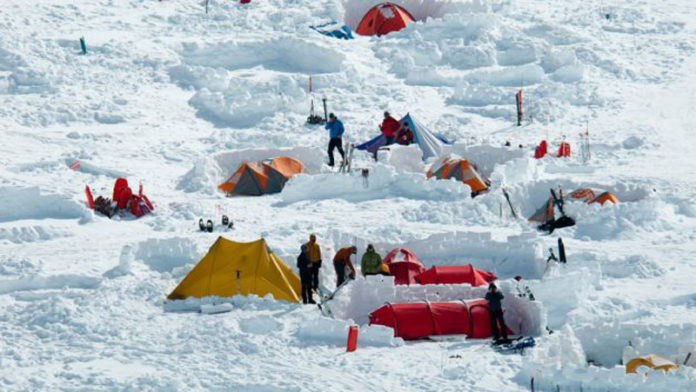According to a new report, due to global warming melting glaciers on Mount Everest are revealing more and more bodies of dead climbers. Almost 300 lives have been lost to the frozen peaks of Everest since the first attempt to conquer the mountain in 1921. Recent expeditions to recover some bodies have sparked heated debate in the about the morality of risking more lives to retrieve bodies from one of the most unforgiving places on Earth.
Mingma David Sherpa first sighted a dead body when he climbed the Mount Everest in 2010 as a twenty-year-old. Seasoned climbers are aware that the route to the summit was dotted with over 200 corpses, often used as markers for distance and altitude. For instance, Mingma knew that when he saw “Green Boots”, the frozen corpse of an Indian climber recognized by the color of his neon-green footwear, that he’d entered the “Death Zone” about 8,000 meters above sea level.
In 2016, Mingma teamed up with Anthony Gordon, an Australian TV producer, and conceptualizer of a documentary on the world’s first Sherpa rescue team. The seven-member team of these Nepali mountain guides was trained to operate cameras and the video footage from their rescue missions was aired as a documentary, Everest Air.
Mingma’s heroic team has rescued and retrieved bodies of 52 people from Everest and its neighbor Makalu, the fifth highest mountain in the world. But the hostile terrain was not the only challenge. The ever-present threat of man-made climate change has hit the region bringing unseasonably warm weather that triggered an avalanche at the Khumbu glacier en route to Everest, killing 16 people just the previous year.

On some occasions, dead bodies, some who’ve been lost for years, have started emerging from the ice. And along with them, tons of garbage including cans, bottles, discarded climbing gear, and human waste are exposed defrosting along the route used by mountaineers over decades. More than 5,000 kilograms is human waste at the base camp.

A five-year study conducted by the International Center for Integrated Mountain Development (ICIMOD) revealed that the glaciers in the Hindu Kush and the Himalayas are melting rapidly and threatened to shrink to approximately a third of their size if CO2 emissions are not controlled.

In 2019, Everest recorded its highest ever number of fatalities at 12 after a bottleneck of climbers got stuck in a storm. The viral image above was snapped the nearly 200 climbers stuck in a “traffic jam” at the peak. The Nepalese Government had issued a record 383 climbing permits for Everest and was criticized for recklessly monetizing such a fragile ecosystem.
Many opine that the responsibility for cleaning up should be shared between the private stakeholders and civil society. Ang Tshering Sherpa, whose four generations of family have earned their living off leading Everest expeditions, says clean-ups aren’t just good for the environment but can also make business sense.
This clean-up was privately funded and needed thousands of dollars. With government-funded efforts not forthcoming yet, such operations can only be replicated sporadically.


Since 2008, Asian Trekking Pvt Ltd, Ang Tshering’s travel agency, has dedicated 20 % of its profits to annual clean-ups. The agency’s “Eco Expeditions” have in the meantime collected over 20.2 tons of garbage accumulated above Everest’s base camp along with seven bodies from above 8400 meters.
Pushed by several such volunteer efforts, the Nepalese government in 2014 introduced a rule that each trekking group is to deposit $4,000 before ascent. The deposit is refundable and processed after climbers come back with 8 kilograms [17 lbs] of garbage each. To control the problem of human feces, they beseech climbers to collect everything in bags and dispose it all after descent. According to Tshering Tenzing Sherpa, a coordinator with the NGO Sagarmatha Pollution Control Committee (SPCC, this has proven to be an effective measure.


Earlier this year, the SPCC was contracted by the government to lead a clean-up operation. In spring 2019, when mountaineers were given access to the Everest trial, a team of eight scoured the mountains and returned with 10.5 tons of garbage and seven bodies. Tshering Tenzing says he plans to continue the operations for at least another five more years. But regardless of these efforts, there are still about 30 tons of trash left on the mountain, according to an estimate by the Everest Summiteers Association. Recently, the Nepali government banned the use of single-use plastic in the Everest region. To decrease the number of deaths, they are also planning to control permits to those who have climbed at least one 6,500 meter peak in Nepal before they attempt Everest.
For all such actions, the most effective solution involves education, environmental awareness, and sustained effort, according to Tshering Tenzing.




















































